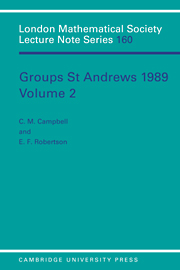Book contents
- Frontmatter
- Contents
- Preface
- Introduction
- 17 A survey of recent results on projective representations of the symmetric groups
- 18 Some applications of graded diagrams in combinatorial group theory
- 19 Rational growth of wreath products
- 20 The modular group and generalized Farey graphs
- 21 On the n-centre of a group
- 22 Existentially closed finitary linear groups
- 23 Permutability and subnormality of subgroups
- 24 Some applications of powerful p-groups
- 25 Combinatorial aspects of finitely generated virtually free groups
- 26 Problems in loop theory for group theorists
- 27 Sylow theory of CC-groups: a survey
- 28 On the minimal number of generators of certain groups
- 29 Lie properties of modular group algebras
- 30 Observations on a conjecture of Hans Zassenhaus
- 31 The Fibonacci groups revisited
- 32 Galois groups
- 33 Infinite simple permutation groups - a survey
- 34 Polynomial 2-cocyles
30 - Observations on a conjecture of Hans Zassenhaus
Published online by Cambridge University Press: 13 March 2010
- Frontmatter
- Contents
- Preface
- Introduction
- 17 A survey of recent results on projective representations of the symmetric groups
- 18 Some applications of graded diagrams in combinatorial group theory
- 19 Rational growth of wreath products
- 20 The modular group and generalized Farey graphs
- 21 On the n-centre of a group
- 22 Existentially closed finitary linear groups
- 23 Permutability and subnormality of subgroups
- 24 Some applications of powerful p-groups
- 25 Combinatorial aspects of finitely generated virtually free groups
- 26 Problems in loop theory for group theorists
- 27 Sylow theory of CC-groups: a survey
- 28 On the minimal number of generators of certain groups
- 29 Lie properties of modular group algebras
- 30 Observations on a conjecture of Hans Zassenhaus
- 31 The Fibonacci groups revisited
- 32 Galois groups
- 33 Infinite simple permutation groups - a survey
- 34 Polynomial 2-cocyles
Summary
Introduction
Let G be a finite group and R an integral domain of characteristic zero, in which no rational prime divisor of |G| is invertible, K is the field of fractions of R. By RG we denote the group ring of G over R, and e : RG → R is the augmentation.
The following is a conjecture of Hans Zassenhaus for R = Z:
(1.1) Let RG = RH as augmented algebras for a finite group H. Then there exists a unit a ∈ KG such that aHa−1 = G. (Such an element a would then automatically normalize RG.)
Since the hypotheses on R guarantee that finite subgroups in V(RG), the units of augmentation one in RG, are linearly independent over R [B], it is enough to assume in (1.1), that H is a finite subgroup in V(RG) with |G| = |H|.
The isomorphism problem asks,
(1.2) whether RG = RH implies that G and H are isomorphic.
A positive answer to the Zassenhaus conjecture would settle the isomorphism problem positively, but it also would give information about the embedding of H in V(RG).
If the isomorphism problem has a positive answer, then the Zassenhaus conjecture is equivalent to:
(1.3) Let a be an augmentation preserving automorphism of RG. Then a is the composition of an automorphism induced from a group automorphism followed by a central automorphism; i.e., an automorphism fixing the centre elementwise. (This is just the Skolem-Noether theorem.)
- Type
- Chapter
- Information
- Groups St Andrews 1989 , pp. 427 - 444Publisher: Cambridge University PressPrint publication year: 1991
- 1
- Cited by



